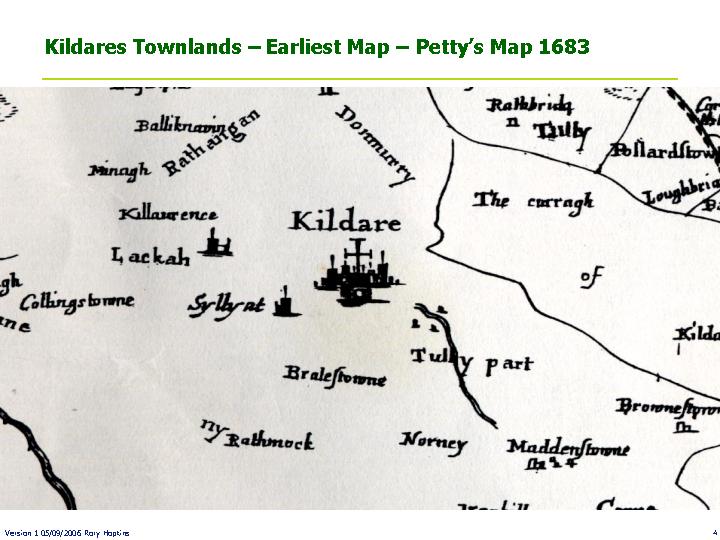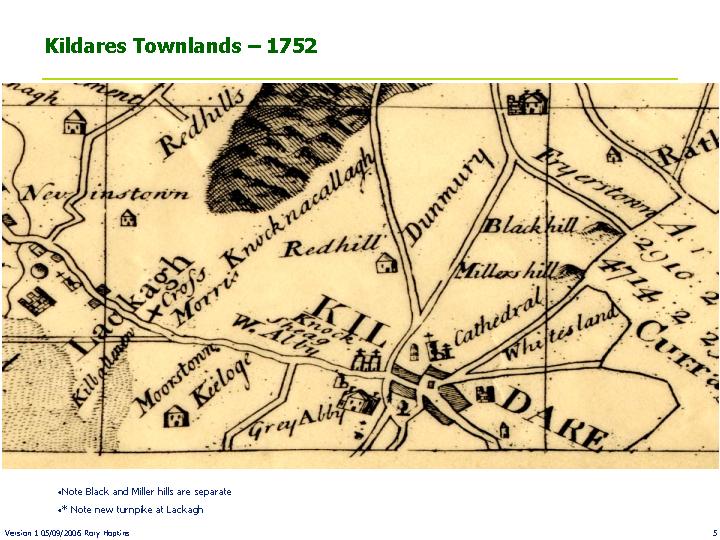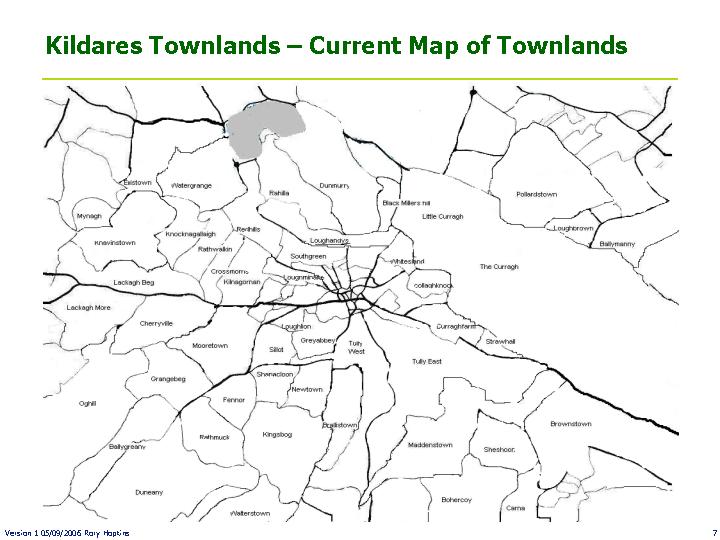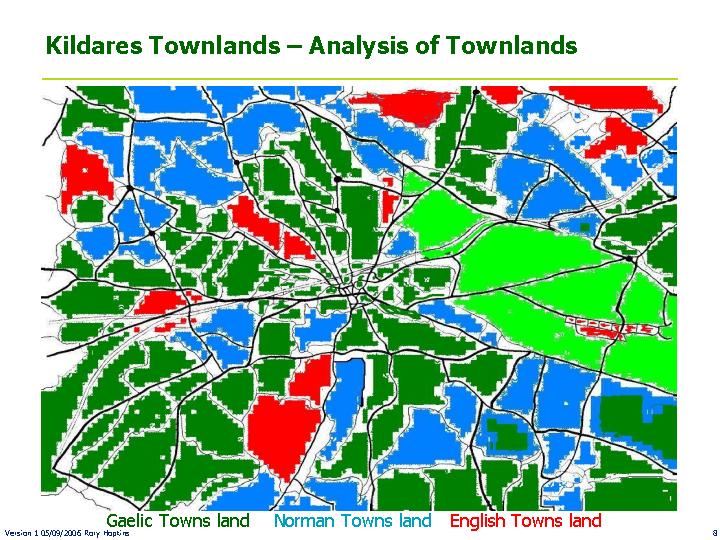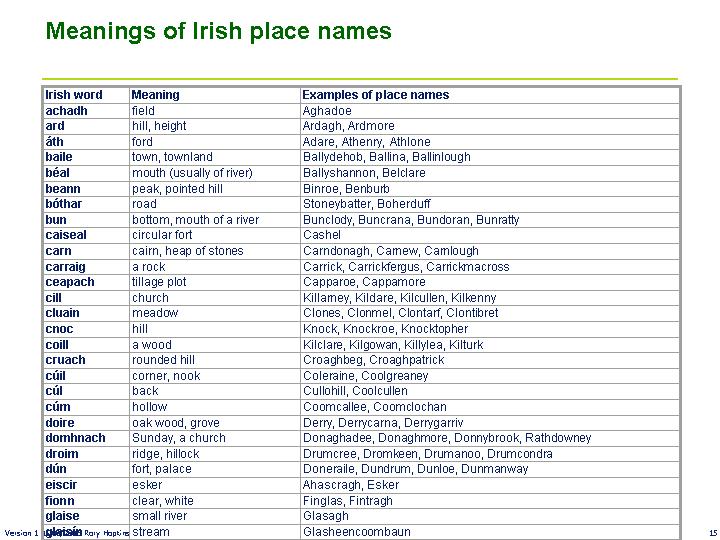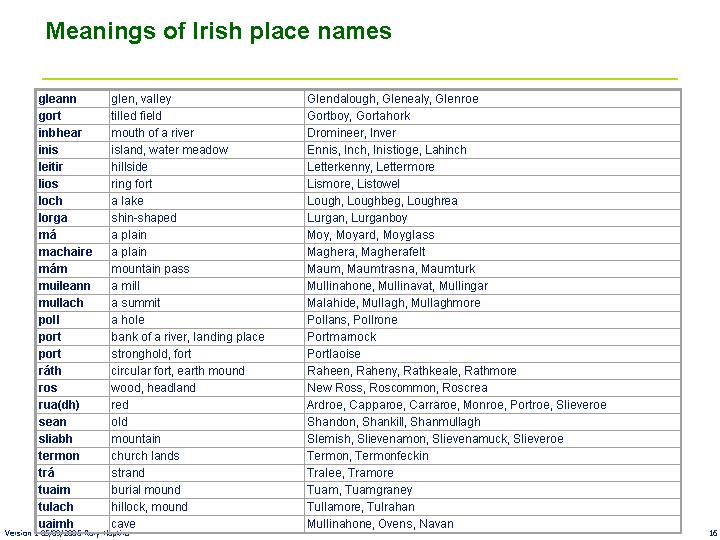August 29, 2007
Cill Dara Historical Society Talk - Hill of Allen by Sean Byrne
Cill Dara Historical Society
Kildare Town's Local History Group
presents
The Hill of Allen
with
Sean Byrne
Wednesday 5th September
8 p.m. Kildare Education Centre (Old Parochial House)
Friary Road, Kildare Town
Sean Byrne having delivered an excellent talk in 2006 on Kilmeague, returns to Kildare Town with a talk on the Hill of Allen which is being hosted by Cill Dara Historical Society, Wed. 5th Sept. 2007
Posted by mariocorrigan at 10:47 AM
July 12, 2007
KILDARE BARRACKS by Mark McLoughlin; Local History Lecture 2005
Kildare Barracks
Wednesday 7th September 2005
by
Mark McLoughlin
The other important event at the turn of the century was the decision to construct an artillery barracks at Kildare which would remain open for almost 100 years until it closed in 1998.
Royal Artillery
The decision to construct an artillery barracks at Kildare in 1900 was one of the most important events in the development of the town. The site of the barracks was on a farm called Broadhook Farm. It was the site of the Lock Hospital which was built in 1868 on lands leased from the Duke of Leinster and remained open for approximately 20 years. However the road it was built on is still called Hospital Street today.
The 1901 Census records the barracks as the Lock Hospital consisting of four camp hutments with 65 carpenters and joiners, Irish and English involved in the construction of the barracks. Living in the canteen were 26 English plasterers and painters. The foreman was a Thomas Ryan from Kildare and a Thomas McLoughlin from Kildare operated a public house on site.
The Leinster Leader recorded a social night in January 1901:-
“On Saturday night last the Irish foremen and timekeepers employed at the military barracks in course of erection in Kildare, entertained their English friends in the same employment. A number of guests were invited, and when supper was served at twelve o’clock about fifty sat to table. The health of the strangers was proposed and Mr. Oram foreman, responded in suitable terms. Dancing commenced after supper, the music being supplied by the employes [sic]. Songs were also rendered by Mr. Oram, Mr. White, Mrs. O’Brien, Mrs. Studley, Miss Dollard, Miss Farrelly, and Mr. McLoughlin. Proceedings were kept up until the small hours, when the party separated well pleased with their night’s pleasure. Messrs Behan, Hickey, and Murphy, who organised the entertainment, are to be congratulated on the success of their efforts.”
The barracks was occupied some time in 1901 and the first units stationed in the barracks were the 31st and 33rd Brigades, Royal Field Artillery – which consisted of five batteries of artillery.
The opening of the barracks provided a period of prosperity for Kildare because by the time of the census of 1911, the population had increased to 2,639 persons which included the 808 men stationed in the Barracks.
The onset of the First World War of course brought great excitement to the town – Military leave was cancelled and military intelligence took over Kildare Railway Station. Kildare Barracks was virtually emptied as the men in Kildare (15th Brigade RFA) were part of the Fifth Division which went to France in August 1914.
The Kildare Observer of 22 August 1914 reported
"A couple of large detachments of the Royal Field Artillery left Kildare Barracks early on Sunday and Monday mornings. They on each occasion being played out of the town by the band of the Kildare Volunteers, which rendered such tunes as "Come back to Erin", etc. Though it was 2 o'clock on Sunday morning, never the less a large crowd of Kildare Townspeople assembled to cheer them off and this was repeated on Monday morning at 7 o'clock. Such warm demonstrations must have helped to bring gladness to the hearts of those men who were going forth to defend our nation's right, and also to their wives and relatives from whose presence they have been called for an indefinite period."
They left a great store of uniforms behind them which were used for a new unit being established in the barracks. Many of these men, no doubt were killed in the next few years in France and other battlefields around the world. There were, of course, also locals killed in the war. Harry Greene, a teacher in Kildare National School applied for a commission on 13 May 1915 and was commissioned into the Royal Munster Fusiliers. He was killed on 29th April 1918 by a sniper after leading a company of Royal Irish Rifles in taking over a german machine gun post.
There is a letter published in the North Cheshire Herald at Christmans 1915 written by some men of the 3rd Cheshire Yeomanry who were stationed in Kildare at the time. They wrote “We spent our Christmas at a little village called Kildare, where the houses are just like stables. You talk about being among the pigs, we are amongst them..”.
Following the war of Independence and signing of the treaty, the British made plans to vacate the barracks in April 1922. However on 10th February 1922 Lieutenant John Wogan Browne, a member of a well known family from Naas at the time, went to the Hibernian Bank to collect the regimental pay. At the corner of Infirmary Road a car pulled up and one of the occupants grabbed the bag which contained £135. Wogan-Browne attempted to recover the bag and was shot in the head. The car was driven by a Tom Graham from Kildare who hired the car out to three men who held him at gunpoint. Three men, who were all local, were arrested for the murder but were released a few months later. All passes for traders to the Barracks were cancelled and on the night of the funeral there was some trouble by British soldiers in the town.
A dance was held in the Barracks at the end of March 1922. While the soldiers danced, someone stole the safe from the canteen which was later found opened in the field behind the barracks. The furniture from the Officers’ Mess and Officers’ Married Quarters was sent north while the rest of the equipment was given to the new state. The families of all soldiers left the barracks on 15th April 1922 when it was handed over to the National Army.
Civic Guards
In February 1922 Michael Collins had established a committee to examine a replacement force for the RIC and within a month had decided on the establishment of the Civic Guard. Following the withdrawal of the British army, the barracks was selected as the site for the training of the new Civic Police and 800 men were sent to the new Civic Police headquarters on 25th April 1922. where the new recruits engaged in drill instruction and route marches to Newbridge and Monasterevin. Within a week of arriving the civic police were attacked by anti-treaty forces and soldiers were put on the gate to protect the barracks. There were simmering tensions in the barracks when the new recruits arrived as they found themselves being instructed by former RIC men. These experienced policemen were appointed over former republicans and tensions came to a head on 15 May 1922 when a former Cork IRA man, Thomas Daly presented an ultimatum to the Commissioner of the Civic Police demanding the expulsion of five named former RIC men. Commissioner Staines ordered a full parade of the barracks and when he ordered the signatories to step forward, a shouting match ensued and the parade was abandoned. The next day, Newbridge Barracks was handed over to the Civic Guard and while the commissioner was there, the mutineers raided the armory and seized rifles, revolvers and ammunition. Meanwhile, Staines had called for soldiers who had just taken over the Curragh from the British to assist the Civic Guard. They arrived in Kildare but were prevented by armed civic guards from entering the barracks and a stand off ensued. The situation was so serious that Michael Collins came to Kildare and agreed to set up an inquiry provided that Staines and other senior Civic police be allowed back to Kildare.
However, when Staines arrived at the gates, he was refused entry and when two former RIC men, Sergeant Patrick McAvinia and Superintendant John Byrne arrived at the gates, the mutineers drew weapons and Byrne was narrowly missed by a shot. The two ex RIC men fled while being chased by a mob and fled to the Railway Arms where they tried to make a phone call. A crowd gathered outside and threatened to burn the place down. They escaped out the back door and hid in the Carmelite house before escaping back to Dublin the next day.
Tensions did not completely finish as on 17th June, days before the start of the Civil War Daly again met a force of anti-treaty men from Dublin who went with him to the barracks, tied up the guards on duty and commandeered the rifles and ammunition from the armoury with some of the Civic Guards joined them and went back to Dublin to the Four Courts.
The overall impact of these events were that the new police force was reconstituted as an unarmed police force which aimed to have closer links to the wider community and much less like a colonial police force in the way the RIC was perceived.
Artillery Corps
In March 1925. the Garda Siochana moved out and the Artillery Corps which was formed in 1923 moved from Dublin to Kildare. On 20th March 1925, the Artillery Corps arrived at Kildare railway station and the two batteries consisting of eight guns in total were each linked and harnessed to six horses and travelled to the barracks with outriders on the lead horses. Artillery requires specialist knowledge and accordingly, the new army gathered together men with previous experience of artillery and horsemanship to create the new unit. Thus you had men like Sgt Major Downey who had seen active service during the war at Vimy Ridge, Bertie Thompson, formerly of the Royal Canadian Artillery and my own grandfather James McLoughlin of the Royal Garrison Artillery. Kildare initially had one battery consisting of 5 Officers, 18 NCOs and 93 gunners (116 in total).
Like the British army, the Irish army battery included 1 farrier, 2 shoeing smiths, 2 saddlers, 5 signallers, 2 Trumpeters, 3 cooks, 2 clerks, 4 sergeants, 40 gunners and 29 drivers. Each battery had 4 18 pounder guns. The smiths and farriers would have been busy as two batteries of artillery required a regulation 125 horses.
The Artillery Corps was renowned for its strict discipline which was far stricter than other army units – with the highest standard of training, drill and dress.
The Artillery Corps carried out their first shoot in the Glen of Imaal in September 1925 with the men having to haul the guns over Table Top mountain. At the time with the formation of new batteries, each battery was assigned to a particular Battalion of the army. So, the 1st Battery was assigned to the 4th Battalion in Cork and when they held their exercises in Kilworth, the battery had to organize a special train to transport all the horses and equipment. This would take from 4 am to 8 am that evening to get the battery to Cork whereas the 2nd Battery only had to travel to the Glen of Imaal although this would in itself be an endurance as all movement was by horse. During the 1920s and 1930s, the entire artillery corps was based in Kildare so a number of Officers were sent to America and to England for Artillery training which they in turn passed on to others on their return to Kildare.
The replacement of the hutted artillery lines with a proper barracks commenced in 1938 when Sisk were given the contract to construct a new barracks and the artillery corps transferred temporarily to Plunkett Barracks in the Curragh. This was the first purpose built barracks built by the Irish State. The barracks was named Magee Barracks after Gunner James Magee who bravely handled a six pounder gun at the battle of Ballinamuck in September 1798.
The biggest change for the Artillery Corps in Kildare was the changeover to a mechanized artillery corps. In March 1939, most of the horses were sold at public auction in Dublin and the remainder given to other units in the army.
With the reorganisation the army in the 1990s, the days of Kildare Barracks were finally numbered and it closed in 1998. Yet again the business community and people of Kildare wanted to know what would become of the barracks. After a number of years as a home for Kosovan refugees and asylum seekers from around the world, the barracks will shortly make way for the needs of an expanding town.
Posted by mariocorrigan at 11:00 PM
July 06, 2007
THE CURRAGH - A LAND DIVIDED by Guy Williams
THE CURRAGH – A LAND DIVIDED
Paper delivered By Guy Williams as the 2007 Hayden Lecture, to Cill Dara Historical Society, Kildare Town’s local History Group, on Wednesday 4th July 2007.
It has been said that the key to the present is to be found in the past, if we but choose to look.
On the flip side, HEGEL chose to differ. “What experience and history teach is this – that people and governments never have learned anything from history, or acted on principles deduced from it.”
One of our own – GEORGE BERNARD SHAW – developed HEGEL'S theme in his 'Revolutionist's Handbook' and again in 'Heartbreak House'.
In the course of this talk I hope to show that both theories contain degrees of validity.
So, what exactly is the Curragh of Kildare?
Well, it's 4,870 acres of limestone plain, covered by grey-brown PODZOLIC soil, draining to Pollardstown Fen. 'Podzolic' is defined in the Oxford Dictionary simply as “a soil with minerals leached from its surface layers into a lower stratum.” Nothing very special about that, really.
I prefer to concentrate on how the Curragh was created. Particularly the legend of 5th century priestess St BRIGID asking the local king for a patch of land on which to build her monastery, in return for relieving him of his asses' ears that had been the bane of his life.
The king played it cute, telling St Brigid that she could have as much land as her cloak would cover. Brigid quickly gave her response. Summoning three of her acolytes she instructed each of them to grab a corner of her garment and head off northwards, eastwards and westwards.
This they did, until each was brought to a halt, all for different reasons. The first was crossed in her tracks by a hare. The second was confronted by a red-haired woman and the third by a blacksmith brandishing a red hot horseshoe.
Well, Brigid hadn't done badly, had she? 4,870 acres of the finest limestone land, Podzolic to boot.
As to how the Curragh got the name 'the short grass' – over-stocking was held to be the cause.
However, GIRALDUS CAMBRENSIS, writing in the 12th century, saw it rather differently. “There are also here the most delightful plains, which are called the pasturage of St Brigid, into which no one dares to enter a plough and of which it is estimated as a miracle that although the cattle of the whole province may have clipped the grass close to the ground in the evening it will appear the next morning as high as ever, and it has been said of these pastures: 'As much as the herds crop during the long day, so much does the cold dew restore during the short night'.”
John O'Donovan, in his study of the antiquities of County Kildare, carried out in 1837, found no reference in ancient lore to the Curragh as a plain. Its creation was attributed to St Brigid and the story of her cloak. Content to leave well alone, O'Donovan concluded: “If tradition could be relied on it would prove that it was first formed in a common by the saintess.”
The saintess had long gone down beside St Patrick, appropriately in DOWNPATRICK, when her Dublin successors obtained free grazing rights on the Curragh. These were the Augustinian Canons of St Thomas of Dublin, the first 'outsiders' to enjoy such rights.
The Augustinian Canons of St Thomas weren't allowed much time to enjoy unfettered access to the Curragh. In 1207 the Curragh of Kildare became royal property, initially through the marriage of Aoife, daughter of Dermot, king of Leinster, to Strongbow. Dermot might have summoned Strongbow from Wales to sort out local grievances. But Strongbow acted for the English crown.
This would seem to be the first instance whereby the English crown gained title to the Curragh of Kildare. At all events, in 1299 Edward I of England enacted a Statute forbidding the feeding of swine on the Curragh. Clearly the pigs were damaging a sward described as “forming a more beautiful lawn than the hand of art ever made. Nothing can exceed the extreme softness and elasticity of the turf, which is of a verdure that charms the eye, and is still further set off by the gentle inequality of the surface.”
In the 16th and 17th centuries the Crown issued grants of pasture commonage to landowners adjacent to the Curragh. Grantees included Robert Bathe, John Lye of Rathbride, Patrick Sarsfield, Sir Nicholas White, Robert Nangle, Edward Medlicott and Garrett Weasley. As late as 1866 the solicitor representing the heirs of these grantees claimed to the Curragh Commission he could “give evidence of rents paid under these patents, some to the present day. Some were purchased by the Duke of Leinster, and in that way some were extinguished.”
So, we have the SHEEP FARMERS established on the Curragh, paying their dues to the Crown of England.
However, they were soon to share the amenity. In 1599 the Earl of Essex, Lord Lieutenant of Ireland, encamped 27 ensigns of foot and 300 horse, declaring: “A better place for deploying of AN ARMY I never beheld.”
In 1641 James Butler, 1st Duke of Ormonde, billeted his army round the Curragh. Two years later Lord Castlehaven took Tully Castle, encamped on the Curragh, “whence I summoned all the castles thereabouts, and had them yielded.”
In 1687 Richard Talbot, Earl of Tyrconnell, encamped his army at the Curragh. That same year we find the first reference to a CURRAGH RANGER, appointed by the Crown, paid £20 a year, along with his livery. He was charged with protecting the grazing rights and game, as well as preventing encroachments.
Two years later the army of James II – 4,400 strong – trained on the Curragh. And the following year the same army rested up on the Curragh following its defeat at the Battle of the BOYNE.
The time had come for a third party to enter the stage that is the Curragh of Kildare – the RACING MEN.
While racing may indeed have taken place on the Curragh of Kildare since prehistoric times, it was in 1696 that the first KING'S PLATES – 2 worth £100 each – were run on the Curragh. Two years later travel writer JOHN DUNTON recorded his impressions. “We soon came to the Curragh so much noised here. It is a very large plain covered in most places with heath; it is said to be five and twenty miles round. This is the NEWMARKET of Ireland, where the horse races are run, and also hunting matches are made, there being a great supply of hares, and more game for hawking, all of which are carefully preserved. . . on this noble plain.”
If the Curragh of Kildare stood comparison with Newmarket in 1698, it is reasonable to assume that it had existed as a major racing centre well before 1696 when those King's Plates were presented.
But the SHEEP FARMERS and the RACING MEN were not to have the Curragh to themselves. In 1709 occurred the first record of ARMY manoeuvres on the Curragh, under Lord Cutts. This development was welcomed by local farmers, who found a ready market for horse fodder, hay and oats. For the time being, anyway, those ARMY summer manoeuvres could be ignored by the RACING MEN. After all, they never lasted for very long and left no permanent mark on the landscape.
The Curragh continued to develop as the racing centre of Ireland, with the great and the good beginning to build their RACING LODGES round the periphery of the Curragh. The earliest known engraving of a horse race on the Curragh dates from 1752.
THE COFFEE HOUSE in Kildare was marked on John Roque's 1757 map, though not completed until 1759. Measuring 40 feet by forty feet, it stood 3 storeys high and was built by subscriptions from the racing fraternity. It was one of Kildare's finer buildings.
Lord Chief Baron EDWARD WILLES visited Kildare in 1760, providing this account. “A very pretty town by means of the gentlemen belonging to the Kildare Hunt. Their number sixty-one, and most of the gentlemen have built for themselves little pretty lodges in the town for the convenience of hunting. I came to the Curragh of Kildare, which is the NEW MARKET of Ireland, and I am afraid as much money betted there as at New Market. 'Tis a plain belonging to the king, of about fifteen miles in circumference. I never saw a finer turf; the sports say the sod exceeds that of New Market.”
Agriculturalist ARTHUR YOUNG added his praise in 1777, describing the Curragh as “a plain sheep walk of above 4,000 English acres, forming a more beautiful lawn than the hand of art ever made.”
At the same time the first reference occurs to a STAND HOUSE on the Curragh. While we know a lot about the COFFEE HOUSE – even if no pictorial record survives – we know nothing of the origins or construction of the original STAND HOUSE.
The MILITARY returned to the Curragh in some force in 1783, when the IRISH VOLUNTEERS raised and held a REVIEW on the Curragh – the Dublin soldiery were transported by the Grand Canal, opened three years earlier. 50,000 spectators were said to have witnessed the Review.
The TURF CLUB was founded in 1790, thereby pre-dating the ENGLISH JOCKEY CLUB. The first Irish Racing Calendar was also published in 1790.
In 1796 six canons were dispatched from Dublin, to assist the High Sheriff in “prostrating the numerous cabins that had been illegally built on the common.”
This might be said to mark the first occasion on which the MILITARY and the SHEEP FARMERS came into direct conflict, for it seems reasonable to assume that the illegal cabins had been put up to house shepherds tending their flocks.
Two years later there was a much more dramatic confrontation – if that's the right word to describe what became known as the 'Gibbet Rath Massacre'.
In 1804 the MILITARY returned once more, this time in vast numbers. Between 13,000 and 16,000 troops were stationed on the Curragh “in light marching order and ready to move at short notice.” Their presence was not so much due to unrest in Ireland as to the Napoleonic Wars. The Battle of Trafalgar took place the following year.
In 1807 the MILITARY changed tack apropos a permanent presence on the Curragh. Water had always been a problem – three Draw wells were sufficient for the indigenous populace, but quite inadequate for thousands of troops and their horses. Instead, the MILITARY opted to build a barracks in what was to become NEWBRIDGE, while still adjacent to the Curragh for exercises. At that time the Curragh of Kildare was under the control of the commissioner of His Majesty's WOODS AND FORESTS AND LAND REVENUES.
Alive to the danger the TURF CLUB used its social influence to get the newly-crowned GEORGE IV to visit the Curragh in the course of his 1821 Royal Visit. Denis Bowes Daly of ATHGARVAN LODGE, many times leading owner, Turf Club Senior Steward and a personal friend of His Majesty, secured the King's consent.
By this time the STAND HOUSE was in a parlous state. It mirrored the economic recession in Ireland in the aftermath of WATERLOO, which brought the Napoleonic Wars to a close.
In his book HORSES, LORDS & RACING MEN – brought out to mark the Turf Club's bi-centenary in 1990 – Fergus D'Arcy commented on the composition of the Committee that was formed to renovate the STAND HOUSE in a hurry. The Duke of Leinster, principal landowner in Kildare, was not a member of the Turf Club. Maurice Prendergast was Senior Steward and Robert Brown Curragh Ranger. In D'Arcy's words: “the composition of the Committee acknowledged the fact that while the Turf Club was the organising body of racing, its actual jurisdiction on the Curragh was one of CUSTOM, not law or right.”
Despite the dreadful weather and the King's unfortunate attack of the 'nimblewherries' the Royal Visit to the Curragh was judged a success. His Majesty presented the Royal Whip, which is still run for to the present day.
ROBERT BROWNE, in his role as Curragh Ranger, had more than the royal visit on his plate. Local landowners – notably the lords Sligo, Cremorne and Rossmore – demanded he take action to protect their rights against “vast numbers of persons, perfect strangers, who have fed and pastured large flocks of sheep and cattle on said Curragh without any right to do so. . . to so great an extent as to render the Curragh almost useless. All three were prominent members of the Turf Club and had horses in training. So they were complaining not just as farmers but as racing men as well.
ROBERT BROWNE got little solace from Dublin Castle, reminded that the Curragh Ranger's duty was to the Crown, not to private persons.
The TURF CLUB decided to take measures into their own hands to protect the racecourses and training grounds by enclosing them. EDWARD RUTHVEN, MP – although a Turf Club member himself – became alarmed at the civil unrest that enclosure could provoke. He persuaded the Kildare Grand Jury to create a new office – CONSERVATOR OF THE CURRAGH. Graydon Medlicott, whose family had been in Kildare since the 16th century, was appointed, his salary to be paid by a tax levied on local landowners. The necessary legislation was based on Acts of 1791 and 1796 safeguarding the rights of commonage on the Curragh.
The Commissioner of WOODS & FORESTS wasn't on for this. He applied successfully to the King's Bench to have the office of Conservator abolished in 1836.
And so it rumbled on. In 1841 Robert Browne, Curragh Ranger, wrote to Charles Gore, one of the Commissioners of WOODS & FORESTS. “There is no document or record in the office of the Turf Club or elsewhere by which it can be ascertained when the Stand House on the Curragh was built. There is no lease or instrument in existence from the Crown to the proprietors of the Stand House.”
In plain language the RACING MEN had got themselves ensconced on Crown lands – and nobody could say how.
Another threat to the Curragh of Kildare appeared in 1843 – the IRON HORSE. Railways actually spread out far faster across Ireland than they were doing in Britain in the 1840s and the Great Southern & Western Railway Company sensed profit in laying a line from Dublin to Tipperary. The most direct – and therefore least expensive – route lay across the Curragh of Kildare. The proposed route would effectively bisect the Curragh plain. In doing so it would also bisect the Royal racecourse.
The RANGER and the TURF CLUB were aghast. This railroad proposal threatened the very existence of the Curragh. Intensive political lobbying ensured that the new menace was rerouted, behind the Stand House, away from the existing racecourses and embanked to obscure the track from view. However, it did result in creating what we know today as the LITTLE CURRAGH, or Curragh Beag.
Negotiating on behalf of the Turf Club, the Marquess of Waterford played an absolute blinder. Indeed, he got the GS&WR to fund the construction of a whole new Stand House, in addition to endowing what is still known as the Railway Stakes. The new Stand House was completed by 1853.
Oh, there were other headaches, as D'Arcy records. “A major problem had developed, with local farmers collecting and drawing huge heaps of manure, causing offensive sights and smells, starving the grass and damaging the surface by skimming. By that stage about 20,000 sheep were grazing the Curragh. One hundred years later less than half that number was said to constitute overgrazing.”
However, the incursion of the railway and the actions of the sheep farmers were nothing to what happened next. . .
The MILITARY returned to the Curragh. And how! The Ranger and the Turf Club found themselves powerless to safeguard the Curragh for racing and training in the face of this threat. What was worse, the authorities – the Crown – totally failed to define the legal jurisdiction of both parties – the MILITARY and the RACING MEN.
The demands of the Crimean War necessitated increasing the strength of the Army. Lieutenant-Colonel H.W. Lugard, Royal Engineers, was ordered to construct a permanent camp to accommodate 10,000 men. Water was sourced at 54 feet. Two thousand were employed in the camp's construction. A postmark – 'The Curragh Camp' – dated August 1855 proved that the new camp had been commissioned.
Curiously, the Army had no plans of former military occupations of the Curragh. Nevertheless, before being transferred to Hong Kong, Lugard had completed the construction of a military town, including hospitals, library, churches, courthouse and recreational facilities on the Curragh's Long Hill. Lugard died in Hong Kong on 30 November 1857, while making the necessary preparations and arrangements as Commanding Engineer for the attack on Canton.
Lord Waterford successfully resisted the claims of the War Office to have the old Stand House put at the disposal of the Royal Engineers. Unfortunately, his premature death in 1859 was to deprive the Turf Club of its most influential protector.
When the Curragh Camp had been completed it was understood that it would be used intensively for drill from April to September and otherwise maintained by a skeleton staff.
However, as Con Costello was to write: “As the strategy of waging war evolved so did the tactics, and the expanse of the plain accommodated the innovations of the tacticians. From the mass movement of man and horse to the employment of mechanism, armoured vehicles and the mass expansion of trench warfare the short grass was constantly fought over, for the next 65 years.”
It was not until 1859 that a Memorandum was drawn up, finalizing legal arrangements to transfer part of the Curragh lands from the Crown to the War Department, whereby the latter confirmed “Her majesty's right to about 4,000 acres in the County of Kildare and subject to such rights of pasturage and common if any as are now legally exercisable thereon.” However, this did not pass into law.
Two years later Queen Victoria conferred royal status on the new Curragh Camp when Prince Edward, Prince of Wales, was posted there. Unfortunately, it didn't work out too well for either the Prince or his Mama. The Prince was deflowered by an actress smuggled in for that purpose, contracting venereal disease that rendered him unfit for marriage. Prince Albert, his father, caught a fatal chill while reprimanding his errant son. Mama never forgave Edward for precipitating her husband's death.
But that was an internal affair, of no particular interest – other than prurient – to the Turf Club. They faced another threat – to the very continuation of racing on the Curragh.
Caretaker Patrick Fahey told the Commissioners of Woods & Forests that “Gun carriages cut the Curragh Turf like a ploughshare.” On the third day of the 1861 September Meeting General sir George Brown “commanded a battery of Armstrong guns to be planted on the course and the cavalry to charge over it and thereby reduced it to the condition of a ploughed field.”
The General's antics held up racing for an hour and the newspaper reporter could scarcely believe this “outrage to the wishes of the leading turf men of our country. We should have thought that the drilling and harassing of the troops for the last month would have entitled them to a holiday during the three days set apart for racing.”
The Office of Woods & Forests remained adamant that compensation was the responsibility of the War Department.
Not content with disrupting racing, General Sir George Brown returned to the offensive in 1862 when he proposed to remove all the gorse from the Curragh. Every other interested party rose up in arms. The trainers were terrified that the remaining roots and stumps would injure their horses. The sheep men claimed the gorse essential for sheltering their sheep. The Kildare Hunt protested at the obliteration of their fox coverts.
Ranger Browne successfully lobbied Whitehall to thwart the General, who proposed to employ military labour in his quest to eliminate all furze from the Curragh. Fortunately, Ranger Browne carried the day.
In 1863 the Turf Club and the War Department went head-to-head. Walsh's Hill gallops had been reduced to a regular swamp. The Flat Rath had been severely damaged by trenching. The Jockey Hall gallops – once the best on the Curragh – had been rendered almost useless due to Ball Firing. Robert Hunter, Keeper of the Match Book for the Turf Club, reported: “From an experience of upwards of forty years I never saw the Curragh in anything like the condition it is now in and the training grounds, Queen's Plate and other Courses are in many places unfit to be worked and raced upon.”
Attack, they say, can be the best means of defence. Cornewall Lewis, Secretary for War, put it up to the Turf Club to inform him as to “what is the nature and rights of the Turf Club on the Curragh.” He did so in the knowledge that the War Department had still not agreed any form of lease with the Office of Woods & Forests.
In 1864 the Office of Woods & Forests offered the Army a lease. The Army declined, seeking instead 'guardianship' of the Curragh.
Ranger Brown inevitably became embroiled in what was now open warfare. He complained to the Office of Woods & Forests that “The Stewards of the Turf Club appear to wish to convert the permissive privileges enjoyed by them into a right and to exercise this right independently of the Crown and its officers which they have no right whatever to assume.
Luckily, the Office of Woods & Forests adopted a conciliatory stance informing the Ranger “The Turf Club must, for the sake of the interests they represent, keep the courses (other than the Royal course) in proper order.”
The controversy got to the House of Commons in 1865. Sir Robert Peel contended that the Curragh was Crown property. Colonel Dunne, MP for Queen's County, disagreed. “The Crown has no rights whatever over the Curragh and the move was an atrocious invasion of public property. Whereas Aldershot had been purchased at great cost, the Curragh has been usurped. It belongs to the Irish people.”
Lord Dunkellin supported the honourable member for Queen's County. He said that it had been known for many years that the Government had faulty title and thus no right to transfer the Curragh to the War department. “The Curragh,” he declared, “is a place of national renown and ought not to be cut up and destroyed. The bargain which the Government in about to make is not only illegal, but would be most obnoxious to the whole country.”
Lord Naas's views earned him a leader in the Leinster Express. Clearly the Military occupation was intended to oust every other interest. The loss of so much grazing was unacceptable. Racing had already suffered. The country could not consent to two such usurpations. Even the office of Curragh Ranger was in danger of being abolished.
The government established the Curragh Commission of Enquiry. It sat in 1866. Major Edmund Mansfield, a member of that commission, later told Lord Walter Fitzgerald, “When the Crimean War broke out in 1854, the military authorities established a camp of instruction on the Curragh without asking the permission of anyone, the idea being that it was only a temporary arrangement.”
On pasturage and commonage, the commission concluded that since St Brigid's time “the dwellers round the Curragh claim and enjoy the rights of pasture which St Brigid and the angels won for them.”
Lord Strathnairn, GOC Curragh Camp, did not miss his opportunity, telling the Commission: “the military and the sheep-owners benefit and accommodate each other, and the poor people of the district (those with rights on the Curragh) believe that the Curragh is their own still, and St Brigid's will is not undone.”
Over the 8 days that the Commission sat no fewer than 23 solicitors and or agents represented the interested parties. The Turf Club's representative scored a badly-needed hit when he successfully showed that through permission given to the Club House in Kildare, the Stewards of the Turf Club could exercise rights over the gallops and courses. He backed up this claim by producing leases to the Marquess of Waterford and the Marquess of Conyngham for the Turf Club and to the Baron de Robeck for the Kildare Hunt.
The upshot was the 'Act to make better provision for the Management and Use of the Curragh of Kildare' in 1868. The Act confirmed the status of the Curragh Ranger – by now the Marquess of Drogheda. He was to care, manage and preserve the plain, appointed by the Lord Lieutenant, not by the Secretary for War.
Moreover, the Curragh was divided into three designated areas – Brown Lands, Blue Lands and Green Lands. The BROWN Lands covered the site of the Curragh Camp (575 acres); the BLUE Lands defined the rifle grounds at 463 acres, while the GREEN Lands formed the residue. The military were henceforth to be confined to the Brown and Blue Lands. However, in times of emergency the Green Lands were to become available to the military for reviews, drills and recreation BY WRITTEN PERMISSION OF THE LORD LIEUTENANT.
Lord Strathnairn voiced his displeasure at the racing fraternity having what he described as “a direct line to the highest level of the Irish government.”
He was even more unhappy when the Lord Lieutenant – the Duke of Abercorn – aired his views. “What is required is that a portion of the Curragh should be set apart wholly and entirely for the purpose of racing: that the care of that portion of the Curragh should, without prejudice to the rights of pasture, be given up entirely to the Turf Club.”
Abercorn felt that the Turf Club should have similar control over that portion of the Curragh to that enjoyed by the Jockey Club over Newmarket Heath. “The granting of this boon to the Turf Club would only be a fair equivalent for the very serious interference with their gallops and exercise grounds which has taken place in consequence of the constant presence of a large military force on the Curragh.”
Better still – on 27 May 1869 a text was signed on behalf of the Crown and the Turf Club conferring a lease to the Turf Club giving the right to race and train horses over the Green Lands – the western section of the Curragh, bounded on the south by the Dublin-Limerick road, for a rent of £5 a year, subject to rights of common and rights of way.
The army might have lost that battle, but they hadn't lost the war. In 1871 they commenced a major reconstruction programme throughout the Curragh Camp, whereby the old wooden and mineral felt roofs were replaced by brick and slate.
Thirty years later – in 1901 – the Curragh camp was designated Divisional HQ, as it was to remain until 1922. That same year the Army made one last bid for outright victory. In July the War Office proposed to acquire the whole of the grazing rights on the Curragh, with a view to their extinction, only to be reminded that the Turf Club had statutory rights there. The Army was further advised that, although the Turf Club's rights were revocable by the Crown, such revocation was unlikely “unless racing on the Curragh comes to an end from other causes.” Otherwise, the Turf Club's 99-year lease, concluded with the Crown in 1882, would have to run its course.
Still the Army persisted and it was not until 1905 that they abandoned their attempts, realising that the Turf Club had successfully lobbied Lord Dudley, the Lord Lieutenant.
Ironically, the final military damage on the Curragh was caused by the War of Independence.
Two years later, as a consequence of the Anglo-Irish Treaty, the lands of the Curragh passed from the Crown to the Minister for Finance and subsequently to the Minister for Defence, administered by his Department's property management branch under the Curragh of Kildare Acts.
On 16 May 1922 the Curragh Camp was formally handed over to the Irish Free State Army. One witness was the future Sister Veronica Treacy, then aged 10. Many, many years later Sister Veronica recalled a snatch of conversation overheard outside a Newbridge pub as the British marched away. “That's the end of them, thank God. Now we can fight away in peace among ourselves!”
George Wolfe TD, the last holder of the historic post of Curragh ranger appointed by the British Crown, died in 1941. The post was then held until 1961 by the chairman of the Office of Public Works, by appointment of the Minister for Finance.
In 1961 the Curragh of Kildare Act abolished the office of Curragh Ranger, at the same time reapportioning the Brown, Blue and Green Lands. The Brown Lands shrank to 77 acres, while the Blue Lands expanded to 815 acres and the Green Lands diminished marginally from 3,382 acres to 3,284 acres. In preparation for the staging of the inaugural Irish Hospitals' Sweepstakes Irish Derby in 1962 the Act empowered the enclosure of the entire racecourse area and the extermination of all grazing rights therein.
Con Costello published his 'A Most Delightful Station' in 1996, recording the history of the Curragh Camp from its creation in 1855 until its handover in 1922. He concluded on an optimistic note. “The classification of the entire Curragh of Kildare as a National monument in 1995, and the proposal to designate as a National Heritage Area, must surely herald a more concerned approach to the use of the celebrated sward. With the good will of the sheep-owners, the horse owners and the military, combined with the interest of the County Council, local residents and the public at large, it is to be hoped that the official confirmation of the scientific and archaeological importance of the plain will ensure that what remains of St Brigid's open pastureland will be respected and its uniqueness safeguarded for generations yet to come.”
Con lived just long enough to contribute an important essay to 'Kildare History & Society', published in 2006. In his piece – John O'Donovan's Curragh – Con quoted from the Department for Defence's report of 2005. Acknowledging the 4,870 acres therein, it declared: “taking the cultural and natural facets of the Curragh together, it is very possibly the only landscape of its kind in the world. . . the area of the Curragh Lands has been used by the military for many hundred years. Various eras of military involvement in the area have resulted in damage to the lands vis-a-vis its status as an open plain, but much of this damage, i.e. Trench fortifications, pillboxes, ranges, etc., is now part and parcel of the plains as they exist today. The Board would be concerned with ensuring that no needless or wilful damage would be caused by any military activity in the future.”
And so say all of us.
Thank you all for your patience and courtesy.
PRINCIPAL SOURCES
Clancy, Padraig – Kildare – History & Society, Geography Publications, 2006
Costello, Con – Kildare – Saints, Soldiers & Horses, Leinster Leader, 1991
Costello, Con – A Most Delightful Station, Collins Press, 1996
Costello, Con – Kildare – History & Society, Geography Publications, 2006
D'Arcy, Fergus - Horses, Lords and Racing Men, The Turf Club, 1991
The Curragh – A Lifetime of Memories – Curragh Local History Group, 1997
The Curragh Revisited – Curragh Local History Group, 2002
[I posted this on the EHistory website also www.kildare.ie/ehistory but as it has a special significance to Kildare Town I felt it should also be on the Grey Abbey site. Great to see yet another packed house at the Cill Dara Historical Society Meeting; a very enjoyable evening]
Posted by mariocorrigan at 02:33 PM
May 26, 2007
Cill Dara Historical Society Annual Outing 2007
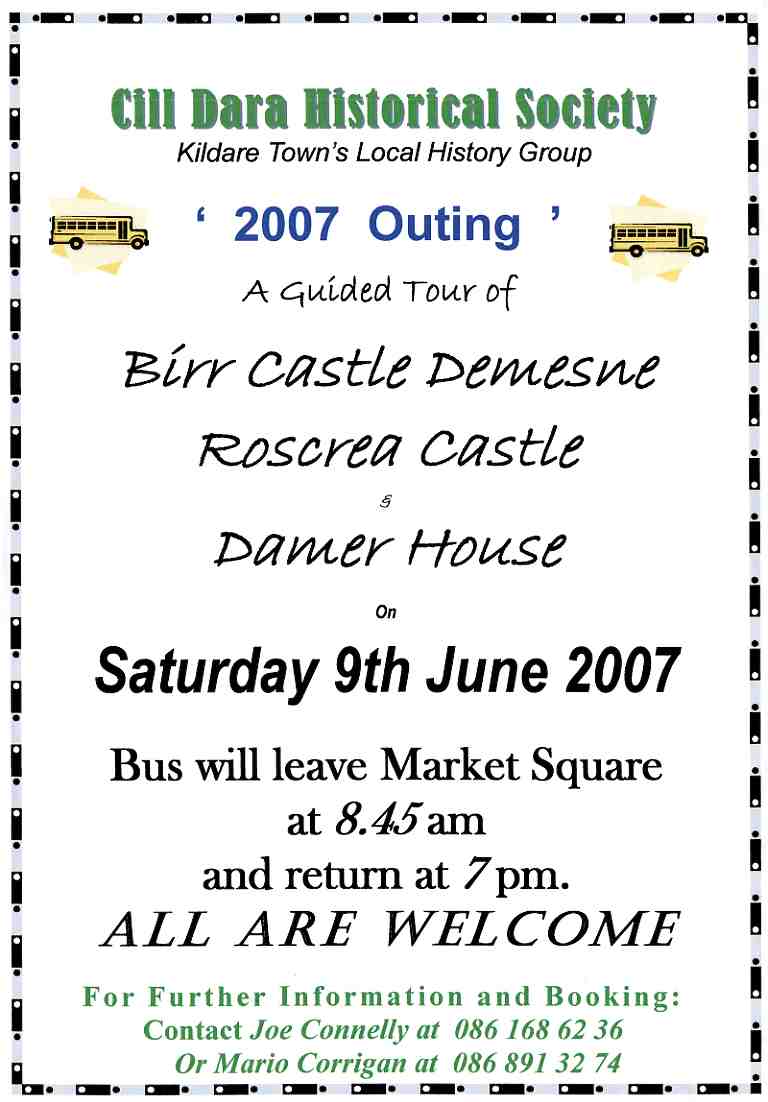
Details of the Cill Dara Historical Society Outing for Sat. 9 June 2007 to Birr and Roscrea - anybody interested should contact us straight away. If it is anything like last years then expect a great day out.
Posted by mariocorrigan at 01:54 PM
February 14, 2007
Successful Local History Meeting
Mr. Zoltan Zinn Collis of Kilkea, Co. Kildare gave a vivid personal account of his life from his early experiences in Slovakia through the horrors of the Nazi Concentration Camp at Bergen Belsen to his rescue and smuggling to Ireland by Irish doctor Bob Collis. You could hear a pin drop in the room as the capacity crowd shared with difficulty the extraordinary personal experiences of Zoltan who was sent to Belsen with his family in late 1944 at the age of four. After hearing the talk I would simply urge people to look for his recently published autobiography - 'Final Witness' for this story can only be told in Zoltan's own words.
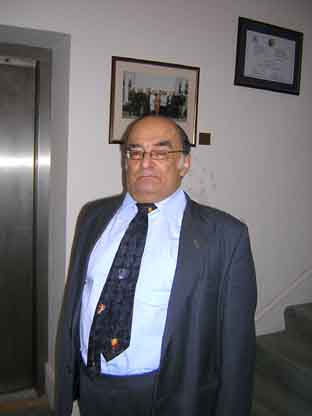
Mr. Zoltan Zinn-Collis at the Cill Dara Historical Society on Wednesday 7 February 2007
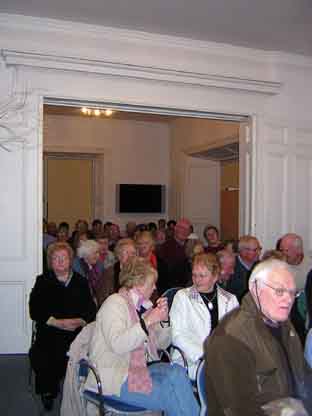
Congratulations to Joe Connelly of the Cill Dara Historical Society for organising Zoltan's visit and to the people of Kildare for a marvellous turn-out. It is great to see the Society going from strength to strength with many new members being added to the list. Full details of the Cill Dara Historical Society 2007 programme are available on this site.
For an excellent review of Mr. Zinn-Collis's book visit Irish Emigrant Online at
http://www.emigrant.ie/article.asp?iCategoryID=49&iArticleID=60069
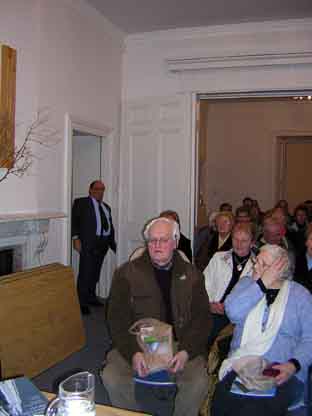
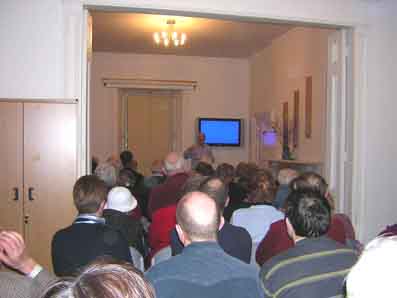
A fantastic crowd turned out in the Kildare Education Centre to hear Zoltan Zinn Collis's excellent talk on his life and experiences from the Concentration Camp at Bergen Belsen to Kilkea in Co. Kildare.
Posted by mariocorrigan at 11:12 PM
January 18, 2007
2007 Schedule for Cill Dara Historical Society
2007
Cill Dara
Historical Society
- Kildare Town's Local History Group -
Series of Talks & Walks
Talks Begin at 8pm
in
The Education Centre Kildare
(Old Parochial House)
Friary Road, Kildare Town.
Wednesday 3rd January
Visit to Clongowes Wood College
~ with Brendan Cullen ~
Wednesday 7th February
'Final Witness' - My Journey from The Holocaust to Kildare
~ with Zoltan Zinn-Collis ~
Wednesday 7th March
'The Forgotten Heritage of Kildare'
~ with Ger McCarthy ~
Wednesday 4th April
'Lifting the Veil on the Nuns' Story' - Enterprising Irish Women Abroad
~ with Dr. Barbara Walsh ~
Wednesday 2nd May
'MacLiammóir - Kildare - Theatre'
~ with Tom Madden ~
Saturday 9th June
Annual Outing to Birr & Roscrea
~ Details will follow ~
Wednesday 4th July
'The Hayden Lecture'
in association with Kildare Derby Festival
'The Curragh - A Land Divided'
~ with Guy Williams ~
Wednesday 1st August
SUMMER BREAK
Wednesday 5th September
'The Hill of Allen'
~ with Sean Byrne ~
Wednesday 3rd October
' Preserving The Heritage of Kildare Town'
~ with Adrian J. Mullowney ~
Wednesday 7th November
'The Hoystead Family of Nurney' - and their present circumstances
~ with Paud O'Connor ~
Wednesday 5th December
'Kildare 1907' - What they said in the Papers
~ with Stephen Talbot ~
Further Information:
Contact Joe @ 086 168 62 36
Another busy and interesting year planned by Kildare Town's Local History Group
[Schedule e-mailed to me by Joe Connelly of the Cill Dara Historical Society]
Posted by mariocorrigan at 07:45 PM
November 03, 2006
THE RORY HOPKINS LECTURE ON KILDARE'S TOWNLANDS
KILDARE’S TOWNLANDS
by
Rory Hopkins
Kildares Townlands - Guide To Irish Land Division
Province –Leinster. In 300 BC, Labhradh Loingseach brought an army of Gauls from France to assist him in recovering the kingdom from his uncle. These foreign soldiers used a kind of broad pointed spear, called laighen [layen]; and from this circumstance the province in which they settled, which had previously borne the name of Galian, was afterwards called Laighen, which is its present Irish name. The termination `ster', which has been added to the names of three of the provinces, is the Scandinavian or Danish stadr, a place. Laighien-ster (the place or province of Laighen) would be pronounced Laynster, which is the very name given in a state paper of 1515, and which naturally settled into the present form, Leinster.
County –Kildare was "shired" by King John Lackland of England in 1210 creating an Anglo-Norman territory to be administered for the crown by the Earls of Kildare.
Barony – East Offaly – The name was derived from Ross Failghe the eldest son of Cathaoir Mor, King of Ireland A.D. 122-125. Ireland was divided into 273 baronies. They were composed of a larger number of townlands than a parish and are said to be an ancient form of administrative unit used for the collection of taxes etc
Civil Parish – East Offaly comprises the parishs Ballymany, Ballysax, Ballyshannon, Concurry, Dunmurry, Grangeclare, Kildare, Kilmeague, Lullymore, Pollardstown, Rathangan, Thomastown & Tully
Towns land - A townland is one of the smallest land divisions in Ireland. There are over 60,000 of them and they range in size from an acre or two up to many thousands of acres. The majority are in the hundreds of acres
Kildares Townlands
“The Townland system is considered to be one of the most distinguishing marks of Ireland and the term townland itself, while unknown in the homeland of the English language is recognised in all parts of Ireland” (O Maolfababhail 1978)
“Townland names like the landscape to which they relate are precious records of the history, legends and mythology of their communities” (Loughrey 1986)
Kildares Townlands – Preamble
Up to 95% of townlands whose names include and a ‘Family name’ followed by
‘Town’ are of Anglo-Norman origin examples of such names are Pollardstown,
Crotanstown, Walshestown, Brownstown and Maddenstown also area’s
with the word Grange which refers to Church land are of Norman
origin. For the purposes of this discussion I will concentrate on the Gaelic
names. I will also include the earliest owner of the land and one owner/tenant
from Griffiths valuation from 1851 if possible.
Gaelic Towns land Norman Towns land English Towns land
Kildares Townlands
The Curragh – Place of horse racing, The word cuirreach means a racecourse. The ancient name of Cuirreach Lifé shows that long ago the original plain reached that river’s banks, but since Anglo-Norman times it has been gradually encroached upon from all sides. The Curragh lay in the ancient territory of Magh Lifé, or Lifé’s plain, so called from Lifé, daughter of Mac Druchta, cup-bearer to Conaire Mór, King of Eire. Hence Abhann Lifé, or the River Lifé, running through Magh Lifé which was situated in the O’Byrne territory of Offelan.
Kildare (Cill Dara) - Church of the Oak
Drumcree (Dromcriadh) - ridge of clay
Tully – The little hill (a rising ground) THE KNIGHTS HOSPITALLERS who lived at Tully were monk soldiers organised to assist pilgrims on their way to the Holy Land and to protect the Places sacred to Christians which were in danger from the Mahommedan Infidels. Their first foundation was a hopsice in Jerusalem.The ensign of the order was a white flag with a black cross. Hence the Abbey was called ‘The Black Abbey.’ Owner 1641 Peter Sarsfield, Landowner/Tenant 1851 : Michael Conway
Botharcoy (Bothar Bui) – The Yellow road
Carna - monument of stones
Kildares Townlands
GreyAbbey -THE GREY ABBEY has its name from the grey habit worn by the Franciscan Friars. Lord William de Vesci built the monastery for the Friars in 1260. Later the lands of Kildare passed to John Fitzthomas and so to the Earls of Kildare. The monastery was suppressed about 1543 and its lands and buildings and valuables confiscated and granted to Daniel Sutton. Some of their property seems to have been overlooked, for in 1589 the remainder was confiscated. Owner 1641 Peter Sarsfield. Landowner 1851 Patrick Lee
Shanacloon – The old meadow (lands belonged to Franciscans 1260) Ballyshannon Naas?
New Town – Typically associated as plantation or post plantation towns (Not mentioned in 1641) Tenant 1851 Philip & Patrick Hopkins
Silliot (Sillagh) – The place of the Sally’s (willows). Owner Peter Sarsfield. Landowner/Tenant 1851 Thomas Heffernan
Fennor (Fionnabhair) – White field. Owner 1641 Maurice Fitzgerald. Landowner/Tenant 1851 John Dunne
Rathmuck – The fort of the pig. Owner 1641 Maurice Fitzgerald. Landowner/Tenant 1851 Martin Kelly
Grange beg - Little Grange 1851 James Behan
Ballygreany – The town of the sandy or gravely place. Owner 1641 Maurice Fitzgerald, Landowner/Tenant 1851 Edward O’Farrell
Kildares Townlands
Oghill – place of Yew wood - Landowner/Tenant 1851 John Hyland
Cross Maurice - 1520AD Battle of Crossmaurice. Maurice FitzGearld killed by the O'Mores of Leix. A cross marked the spot where he was killed.1851 Thomas Fitzgerald
Lackagh – A place full of stones or flags. Owner 1641 James Fitzgerald, Landowner/Tenant 1851 Patrick Fitzgerald
Mynah - Little plain
Knocknagalliagh (Cnoc na gCailleach) – The hill of the nuns. 1641 owner John White. Landowner/Tenant 1851 Maurice Dooney
Knockshough – Hawk hill Landowner/Tenant 1851 Thomas Patterson
Grangeclare (Grainseach an chlair) – Grange of the Plain – outlying farm belonging to Hospital of St. John. Owner 1641 Charles Lord Moore, Landowner/Tenant 1851 Timothy Whelan
Loughminane (Lochminane) - the formation of which is thus accounted for in the Feilire Aenguis in the Leabhar Breac: “Eighteen bishops came to Brigid to Loch Lemnachta, beside Kildare to the north. So Brigid asked her cook whether she had food, and she said she had none. And Brigid was embarrassed, so the angel said the cows should be milked again. And Brigid milked them, and they filled the tubs, and they would have filled all the vessels of Leinster, and the milk came over the vessels, and made a loch thereof. Hence the name Loch Lemnachta, lake of New Milk.” Landowner/Tenant 1851 Mary Cleary
Kildares Townlands
Rathbride – fort of Brigid (common around Ireland associated with places Brigid visited). Owner 1641 John Lye, Landowner 1851
Crockanure (Cnoc-an-iubhair) – The hill of the yew tree
Fearann Dearg (not Bearg)–The red ploughed field
Cloghgerret –The stone (or stone castle) of Garret? Owner/Tenant 1851 Hugh Conlan
Collaghknock – The land at the back of the hill Landowner/Tenant 1851 Patrick Connolly
Rathangan (Rath Iomghain) – Iomgan Rath
Dunmurry – Murray’s Fort, Taxation value 1303 six marks, nine shillings. Owner 1641 Earl Of Kildare, Landowner 1851 Edward Medlicott
Red Hills –“from the redness of the earth I suppose. There is a copper mine here said to be very rich, which is working these three years past, not with that spirit however which can only render undertakings of the kind of public importance.” - TOPHAM Bowden 1790
Carrigin Earle – The Earl’s Castle. Owner 1641 Earl of Kildare
Pollardstown- From the french surname for head (Value of 50 shillings in 1303)
Ballymany (Baile Meadhonach) – Middle Town
Kildares Townlands – The ones that got away!
Kilnagornan – The wood of the black smiths?
Loughandys – The lake of the swamp?
Loughlion – The lake of the children?
Duneany – Fort of the swamp ?
Rathwalkin – Fort of Walkin ?
Monasterevin Townlands
Townlands in the Civil Parish of Monasterevin
The Townland in a Medieval and older territorial division based on a number of plough lands. In later times they formed the basis for rental assessments. The following is a list of townlands, their Irish name and meaning.
Ballyfarsoon: Baile an pearsan. Town of the Parson.
Barraderra: Baire a doire. Top of the oak wood.
Clogheen: Cloicin. A small stone or stone house (possibly St. Evin's bell house or oratory).
Cloncarlin: Cluain Caireallain. Carolan's Meadow (also called Globe Island).
Clonegath: Cluain na gath. Meadow of the spears (possibly meaning battlefield).
Cowpasture: Possibly a commonage area.
Coolnefearagh: Cuail na Fearagh. The men's corner or grassy corner (a place of assembly).
Fearmore: Fiair Mor. Great Meadow.
Gorteen: Guirtin. A small garden or cultivated field.
Gorteenoona: From the same root as Gorteen.
Grangecoor: An out farm of the Cistercian monastery.
Kill: Cill or Coill. A church or wood.
Kilpatrick: Cill Pádraig. St. Patrick's Church.
Larchhill: A hill with a plantation of larch trees ? Does anyone have an Irish name for the area?
Lughill: Liamh Coill. Elm Wood
Millfarm
Monasterevin: Manistir Eimhin. The Monastery of Evin.
Monasterevin Bog: The Bog of the Monastery of Evin
Moore Abbey:Originally called The House of Monasterevan.
Oghill: Eochaill. Yew Wood.
Oldgrange: The old grange or out farm of the Cistercian monastery.
Passlands: Possibly the land of the pass, associated with the Pass Bridge.
Skirteen: Scairtin. A little cluster of bushes or a thicket.
Stramillian
Toghereen: The Little Causeway (tracks over bogs dating to the Late Bronze Age are known throughout the area of Monasterevin).
Notes from the recent excellent lecture on the derivation of townland names delivered by Rory Hopkins to the Cill Dara Historical Society in September.
Posted by mariocorrigan at 09:12 PM
September 07, 2006
AUTUMN SCHEDULE OF LOCAL HISTORY TALKS IN KILDARE
Cill Dara Historical Society
Kildare Town’s Local History Group
2006 Series of Talks
in
The Education Centre Kildare
Friary Road, Kildare Town
(Old Parochial House)
Talks Begin at 8 p.m. (unless stated)
ALL ARE WELCOME
Further Information: 086 1686236
Wednesday 4th October – 1918, THE SPANISH FLU & Co. KILDARE – with RONNIE
KINNANE
Thursday 12th October – In Association with The County Kildare Federation of Local History Groups
‘COMMANDANT JAMES O’NEILL, IRISH CITIZEN ARMY (1917 – 1922) and Quartermaster, GPO, Easter 1916’ – with JOHN COLGAN
Wednesday 1st November – RECENT EXCAVATIONS AT GREY ABBEY – with
EMER DENNEHY – AT 8.30 p.m.
Wednesday 6th December – LILYWHITES ON ICE, POLAR EXPLORATIONS & THE
KILDARE CONNECTIONS – with KEVIN KENNY
Bring along a friend for an enjoyable night with your Local History Group
A fascinating addition to the Local History Schedule of Talks has just been announced for Thursday 12 October 2006 in association with The County Kildare Federation of Local History Groups
‘COMMANDANT JAMES O’NEILL, IRISH CITIZEN ARMY (1917 – 1922) and Quartermaster, GPO, Easter 1916’ – with JOHN COLGAN
Posted by mariocorrigan at 12:42 PM
August 17, 2006
THE ORIGINS OF LOCAL PLACENAMES - KILDARE TOWN AND THE ENVIRONS
Local Placenames
Rory Hopkins will give a talk on the etymylogy of local Placenames in the Kildare Education Centre on Wednesday 6 September as part of the Cill Dara Historical Society's annual programme. It is at 8 p. m. and all are welcome.
Why not consider coming along on the night to learn about the origin of the names of the local townlands and find out a little more about the group and the rest of its programme for this year.
Posted by mariocorrigan at 12:34 PM
January 18, 2006
2006 CALENDAR OF EVENTS FOR KILDARE TOWN LOCAL HISTORY GROUP
2006
Cill Dara Historical Society – Calendar of Events
Talks Begin at 8 p.m. (unless stated)
in
The Education Centre Kildare
Friary Road, Kildare Town
Further Information: 086 1686236
Wednesday 4th January - VISIT TO CURRAGH MUSEUM – with REGGIE DARLING
Thursday 2nd February – THE ANNUAL CELTIC LECTURE in association with Feile
Bhride & The Education Centre Kildare
Wednesday 1st March – THE LOCK HOSPITAL, KILDARE TOWN – with HUGH
CRAWFORD
Wednesday 5th April – KILMEAGUE, BIRTH OF A VILLAGE – with SEAN BYRNE
Wednesday 3rd May – KILDARE DRAMA FESTIVAL, A HISTORY – with JOE
CONNOLLY
Saturday 10th June – ANNUAL OUTING - TO KILKENNY CASTLE
Details to follow
Wednesday 5th July – THE HAYDEN LECTURE – in association with Kildare Derby
Festival – Details to follow
WEDNESDAY 2ND AUGUST – SUMMER BREAK
Wednesday 6th September – KILDARE’S TOWNLANDS – THE DERIVATION OF
THEIR PLACENAMES – with RORY HOPKINS
Wednesday 4th October – 1918, THE SPANISH FLU & Co. KILDARE – with RONNIE
KINNANE
Wednesday 1st November – RECENT EXCAVATIONS AT GREY ABBEY – with
EMER DENNEHY – AT 8.30 p.m.
Wednesday 6th December – LILYWHITES ON ICE, POLAR EXPLORATIONS & THE
KILDARE CONNECTIONS – with KEVIN KENNY
Bring along a friend for an enjoyable night with your Local History Group
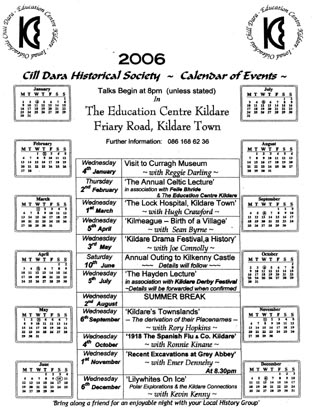
Posted by mariocorrigan at 12:31 AM
October 09, 2005
LOCAL HISTORY TALK A HUGE SUCCESS
Tom Nelson who is currently researching his PhD on Kildare County Council entertained the members of the Cill Dara Historical Society with an overview of the career and life of John T. Heffernan, noted Land Leaguer, supporter of Home Rule and Parnell and the first Secretary of Kildare County Council.
With more than 43 people present the evening proved to be one of the most successful yet which is a great endorsement of the work being done by the group of late considering it nearly disappeared completely at the end of 2004.
Also of note was the presence of many members of the Heffernan family who turned out on the night in support of the Society and in recognition of their ancestors contribution to the development of the town.
The next meeting will be held on Wednesday 2 November in the Education Centre and will be hosted by Seamus O'Kelly who has recently written 'A Ramble in Rathangan.' All are welcome and admission is free.
Posted by mariocorrigan at 11:53 PM
August 30, 2005
AUTUMN SCHEDULE FOR KILDARE TOWN LOCAL HISTORY GROUP
Cill Dara Historical Society
2005 AUTUMN/WINTER SERIES OF TALKS
The Kildare Education Centre, (Old Parochial House), Friary Rd., Kildare
Wednesday 7th September at 8 p. m.
Speaker -Mark McLoughlin
'KILDARE BARRACKS - A HISTORY'
Wednesday 5th October at 8 p. m.
Speaker -Tom Nelson
Author of ‘The Land War in Co. Kildare’ & Researching a PhD Thesis on Kildare Co. Co.
'MR. JOHN T. HEFFERNAN - MEMBER OF THE 1ST KILDARE COUNTY COUNCIL AND NOTED LAND LEAGUER'
Wednesday 2nd November at 8 p. m.
Speaker -Seamus Kelly
Author of ‘A Ramble In Rathangan,’ And ‘Leixlip - A Walking Tour’
‘A RAMBLE IN RATHANGAN’
Wednesday 7th December at 8 p. m.
Speaker - Martin Malone – KILDARE TOWN’S PRIZE-WINNING AUTHOR
' A SENSE OF PLACE'
Further information contact Joseph Connelly 086 168 62 36
Posted by mariocorrigan at 10:13 PM





